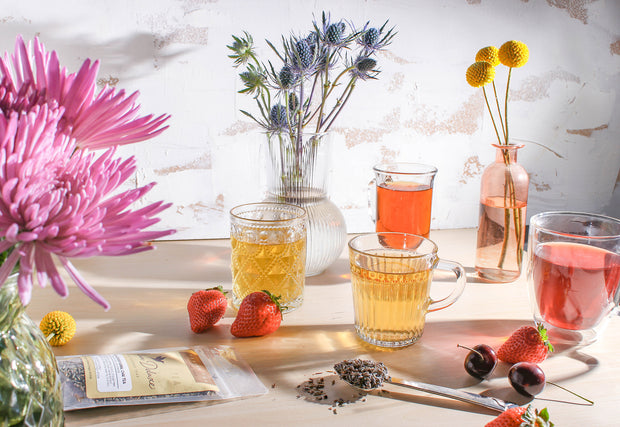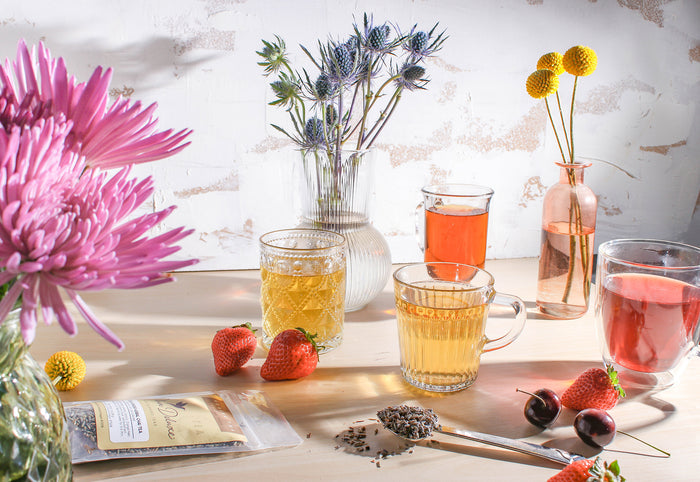So what is it about these scones that make them quintessentially Irish? Well, after extensive reading of both scone recipes and histories, I believe the difference lies in three aspects: the shape, the liquid used, and the choice of dried fruit.

Irish Scone Shape
While in America we love our wedge-shaped scones, in Europe, Australia, and New Zealand you can often choose between a drop scone like our gluten-free blueberry raspberry scones, fried scones like our quick and easy fried scone recipe, and the traditional round cut out variety like these strawberry scones.
Traditional Irish scones are round, often with glossy, golden tops that are tall enough to split easily and layer with clotted cream or butter and jam.

Irish Scone Recipe
There seems to be some debate as to what liquid should go into a proper Irish scone. Should it be double cream, buttermilk, or regular milk?
I personally am a big fan of buttermilk in baking, so that's what I went with. The rich, tangy buttermilk is a scrumptious accompaniment to plenty of salted butter in making a tender and flavorful dough that pairs beautifully with whatever dried fruit you choose to add.
Speaking of fruit, once again debate is strong on whether a traditional Irish scone recipe should be served plain or gussied up with raisins, sultanas, or tiny black currants. While all three are great options, I confess that I love not only the look of black currants in a scone, but also how the baking process makes them extra chewy and the ones on the bottom beautifully caramelized. They don’t overwhelm the scone with big chunks of fruit, either. This provides an excellent excuse, if you need one, to add jam.

Irish Scone Serving Ideas
Once you’ve chosen which side of the three debates you’re on, Irish scones are wonderfully quick and easy to make. Just make sure your butter and buttermilk are cold, and within half an hour you’ll be sitting down with scones fresh from the oven, ready to be slathered in goodness.
If you’re a person of simple tastes, lovely cold butter is a perfectly delicious way to sandwich your Irish scone together, but if you’re a traditionalist, clotted cream and homemade jam are the way to go. If, like me, you have no access to clotted cream, mascarpone is a scrumptious substitute. It is decadent and creamy and won’t completely melt and run all over the place if you can’t wait for your scone to cool to room temperature. Whipped heavy cream is also a good substitute, but you’ll have to wait for your scones to cool before you add it or it will melt quickly and you’ll think you added milk to your scone by accident.

While scones are splendid served with morning or afternoon tea, they’re also lovely added to your main meal. Try serving them alongside a hearty Irish stew or thick seafood chowder with slices of aged cheddar or creamy Camembert instead of clotted cream and jam. If you’re extra daring, you can turn them into scone sandwiches with a smear of mustard and a thick slice of cold corned beef. You may be surprised how delicious the salty meat is with the sweet bursts of dried black currants.
You can also make them part of an Irish dessert table and arrange them on a platter next to our Irish Apple Cake and Tipsy Pixie cookies.
No matter what you serve them with, Irish scones are infinitely better when eaten with a cup of tea. Our Fog Cutter Irish Breakfast with a hint of lemon is an ideal choice. Our other breakfast teas bring England and Scotland to the party with a creamy vanilla twist in our House Blend English Breakfast black tea or warming maple notes in our Heritage Blend Scottish Breakfast black tea.

Irish Scone Recipe
Ingredients:
- 2 1/4 cups all-purpose flour
- 1/4 cup white sugar
- 1 tablespoon baking powder
- 1/2 teaspoon fine sea salt
- 1/2 cup butter, cold, cut in cubes
- 1 cup black currants
- 1/2 cup cold buttermilk
- 1 egg, large
- 2 tablespoons buttermilk, reserved
Directions:
Preheat oven to 425F.
Place flour, sugar, baking powder, and salt into bowl of food processor. Pulse once or twice to combine. Add cold butter chunks and pulse until mixture resembles coarse cornmeal. Pour mixture into large mixing bowl.
Add black currants to flour and butter mixture and gently stir to combine.
In measuring cup, add buttermilk and egg and whisk together well.
Make a well in dry mixture, pour in wet mixture, and stir gently with a fork until dough forms and holds together.
Turn dough out onto floured surface and knead gently once or twice just to make sure dough holds together. Roll out about 1 inch thick.
Using floured cup or cookie cutter, cut out rounds and place 2 inches apart on parchment-lined baking sheet. Brush tops of scones with buttermilk and bake 12-15 minutes until risen and golden brown on top.
Serve warm or room temperature with clotted cream or mascarpone and your favorite jam.

!['Chocoholic' Chocolate Tea Variety Pack [6-Pack Variety of Flavors]](http://www.plumdeluxe.com/cdn/shop/files/2.01-1800x1800-PlumDeluxe-DAJ-274695.jpg?v=1736886689&width=165)
![Patisserie Dessert Tea Variety Pack [6-Pack Variety of Flavors]](http://www.plumdeluxe.com/cdn/shop/files/4.01_-_1800_x_1800_-_Plum_Deluxe_-_DAJ_-_274695.jpg?v=1736886720&width=165)















